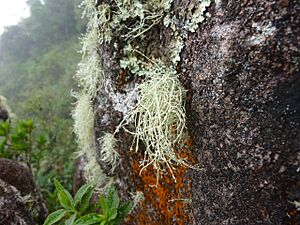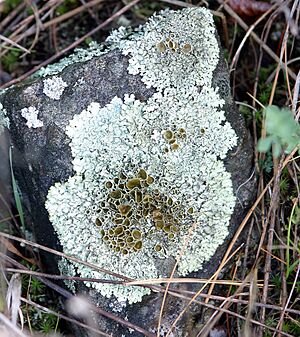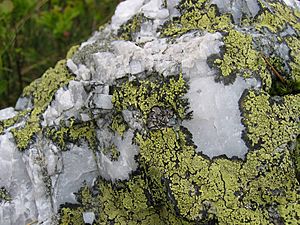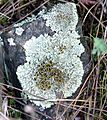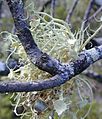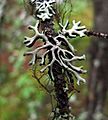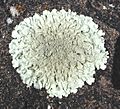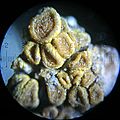Lichen facts for kids
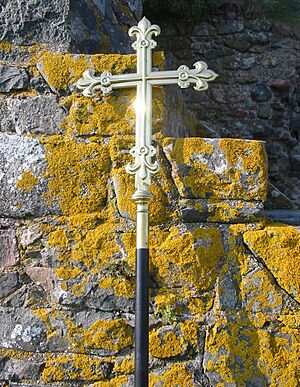
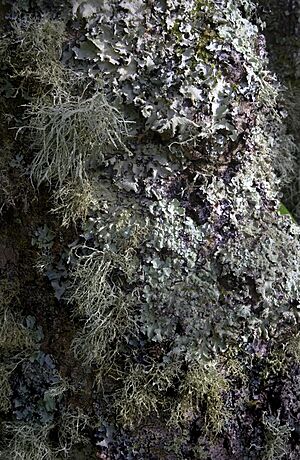

Lichens are like a special team-up between at least two very different living things. This partnership always includes a fungus. The fungus lives with one or more partners that can make their own food using sunlight. These partners are usually a green alga or a cyanobacterium (which is a type of bacteria).
The algae or bacteria live inside the fungus. They share nutrients with each other. A lichen looks and acts very differently from any of its partners alone. It's a unique form of life. Scientists didn't figure this out until around 1875!
Contents
How Lichens Are Grouped
Lichens are a bit tricky for scientists to classify. This is because the different organisms that make up a lichen come from different kingdoms of life. After a lot of discussion, lichens are now grouped as fungi. They get their scientific name from the fungus part of the team. This helps scientists keep track of them.
About one out of every five types of fungi lives in a lichen. Most lichen fungi (over 40%) are called Ascomycetes. These fungi make spores in a special sac-like container. Only a few types of algae live inside lichens. The most common alga is Trebouxia. Other partners can be the orange Trentepohli alga or the Nostoc cyanobacterium.
Where Lichens Live
Lichens usually stick very closely to surfaces. They can be found almost anywhere on land. Some can even live in aquatic (watery) places. You probably have lichens on a nearby rock, wall, or roof. Often, they look like a mat clinging to the surface. Some lichens look like tiny bushes, as you can see in the pictures.
Lichens are amazing because they don't need a constant supply of water. Their bodies can pause their activities when dry and then restart when moisture returns. When growing on mineral surfaces, some lichens slowly break down the surface. This helps them get tiny amounts of mineral nutrients. The fungus makes up most of the lichen's body, while the food-making partner is usually inside.
How Lichens Survive
Lichens are super tough! They can survive in some of the most extreme places on Earth. You can find them in the freezing Arctic, hot deserts, and rocky coasts. They often grow on leaves and branches in rain forests and temperate woods. They can also live on bare rock, walls, gravestones, and exposed soil.
There are about 200 different kinds of lichens in Antarctica. Some have even been found in the Himalaya Mountains at very high altitudes.
The European Space Agency found that lichens can even survive in space! Two types of lichen were sent into orbit on a Russian rocket. They were exposed to the vacuum of space, cosmic radiation, and huge changes in temperature. After 15 days, the lichens were perfectly fine.
Lichens in Rainforests
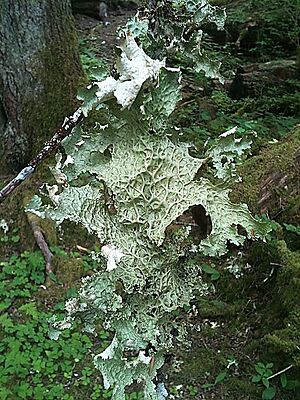
Rainforests have a huge number of lichen species. There are often more types of lichens than flowering plants! Most of these lichens are epiphytes. This means they live on trees without harming them. One small area in Costa Rica had about 300 different lichen species just on leaves. A single fallen tree in New Guinea had 173 species. One single leaf from a laurel tree was found with 50 to 80 lichen species!
How They Help Each Other
In this close partnership, it's hard to say who benefits more. Their success comes from working together. Sometimes, the partners can live on their own. Most algae and all cyanobacteria can survive alone, but in fewer places.
The food-making partner (alga or cyanobacterium) provides food. They make carbohydrates like sugars using photosynthesis. Cyanobacteria also turn nitrogen from the air into a form the fungus can use. This helps the fungus make proteins.
The alga definitely benefits from the water the fungus stores. The fungus also provides protection from the weather and from harmful ultraviolet light. Algae likely get tiny amounts of minerals that the fungus collects from the surface or from dust. Even though some algal cells might be used up for nutrients, they divide and replace themselves. Overall, this partnership is very successful. It allows lichens to live in places where few other plants can survive.
How Lichens Reproduce
Many lichens reproduce without needing a partner. They make tiny groups of algal cells surrounded by fungal threads. These tiny groups, called soridia, can be carried by the wind. Some lichens just break into pieces when they dry out. The wind carries these pieces, and they grow when it gets wet again.
Lichen fungi can also reproduce sexually. They form special fruiting bodies that contain spores. These fruiting bodies can last a long time. Some in the Swiss Alps have lived for over 50 years! After these fungal spores are spread by wind, they must find an algal partner to form a new lichen.
Lichen History on Earth

Scientists know that lichens have existed for at least 400 million years. There are even signs that older forms existed 600 million years ago. This means they were likely among the very first living things on land. Because so many different fungi and algae are involved, scientists think this team-up happened many times with different species.
What Lichens Are Used For
Many lichens are sensitive to changes in their surroundings. Because of this, scientists use them to check for things like air pollution, ozone problems, and metal contamination. Lichens have also been used to make dyes, perfumes, and herbal medicines.
Some lichens produce natural antibiotics that can kill bacteria. People have used these compounds as natural medicines. Extracts from some Usnea species were used to treat wounds in Russia in the mid-1900s.
The map lichen (Rhizocarpon geographicum) grows extremely slowly. It can live for over 1000 years! Scientists can use it to figure out how long a rock surface has been exposed. They measure the size of the largest lichen on the rock.
Lichens are the main winter food for reindeer. The deer can find shrubby lichens under the snow. In summer, they have more food choices. Some lichens are even eaten by humans. A type of lichen called Iwatake in Japanese and Seogi in Korean language is collected from cliffs. It's used in various Korean and Japanese foods. Lichens can have a high level of acid. Be careful, as at least two kinds of lichen are toxic!
The bacterial or alga partners in lichens produce pigments that absorb sunlight for photosynthesis. There are reports from almost 2000 years ago about purple and red colors being taken from lichens. Lichens from the Roccellaceae family are often called 'orchella weed'. They were important historically because they could provide orcein, a dye. Rocella tinctoria is the source of pH indicator litmus. Orcein is made by boiling the lichen, and litmus is made by adding ammonia and air. Orcein is also used as a food dye.
Today, dyes from lichens have mostly been replaced by man-made ones.
Images for kids
-
Lichens on a limestone statue on a tower of Regensburg Cathedral
-
Lichen grown in a Mickey Mouse shape
-
"Lichenes" fancifully drawn by Ernst Haeckel to emphasize his ideas of symmetry in his Artforms of Nature, 1904
-
Lobaria oregana, commonly called 'Lettuce lichen', in the Hoh Rainforest, Washington State
-
Map lichen (Rhizocarpon geographicum) on rock
See also
 In Spanish: Liquen para niños
In Spanish: Liquen para niños


